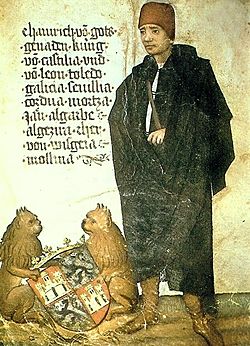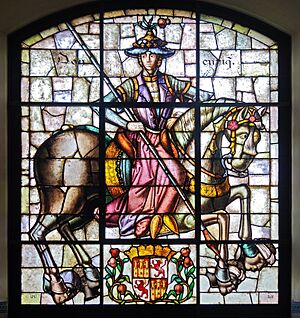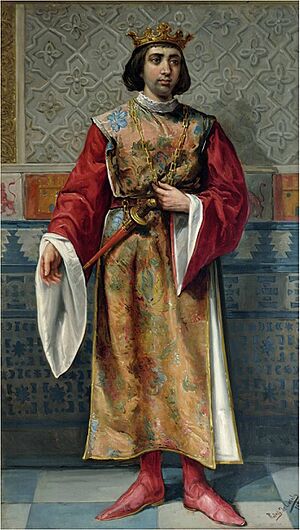Henry IV of Castile facts for kids
Quick facts for kids Henry IV |
|
|---|---|

Depiction in the 15th century journal of Georg von Ehingen
|
|
| King of Castile and León | |
| Reign | 22 July 1454 – 11 December 1474 |
| Predecessor | John II |
| Successor | Isabella I |
| Born | 5 January 1425 Valladolid, Spain |
| Died | 11 December 1474 (aged 49) Madrid, Spain |
| Burial | Santa María de Guadalupe |
| Spouse | |
| Issue | Joanna, Queen of Portugal |
| House | Trastámara |
| Father | John II of Castile |
| Mother | Maria of Aragon |
| Signature | |
Henry IV of Castile (in Castilian Spanish: Enrique IV) was born on January 5, 1425. He died on December 11, 1474. He was the King of Castile and León. Henry was one of the last kings of Castile and León from the Middle Ages. During his time as king, powerful noble families gained more control. This made the country less united.
Contents
Early Life of King Henry
Henry was born in 1425 in Valladolid, Spain. His father was John II of Castile. His mother was Maria of Aragon. She was the daughter of King Ferdinand I of Aragon. Henry became the heir to the throne of Castile. He was given the title of Prince of Asturias.
When Henry was born, a powerful man named Álvaro de Luna, Duke of Trujillo controlled Castile. He chose Henry's friends and teachers. One of Henry's closest friends was Juan Pacheco. He later became a very important advisor. There were always fights and agreements between the nobles, Álvaro de Luna, and the princes of Aragon. Everyone wanted more power.
In 1445, Henry won an important battle called the First Battle of Olmedo. He defeated the princes of Aragon. After this victory, Álvaro de Luna's power became weaker. Prince Henry and Juan Pacheco became more influential.
Becoming King and His Rule
Henry IV's father, King John II, died on July 20, 1454. Henry was declared king the very next day.
One of Henry's first goals was to make an alliance with Portugal. He did this by marrying Joan of Portugal in 1455. She was the daughter of King Edward of Portugal. Henry also met Joan's brother, Afonso V of Portugal, in 1456. Henry also wanted peace with France and Aragon. He also forgave many noble families.
King Henry called a meeting to plan an attack against the Emirate of Granada. The campaigns in 1455 and 1458 were not popular. They were long wars of small attacks, not big battles. The nobles and the people did not like them. Juan Pacheco and his brother Pedro Girón were in charge of government decisions. Henry also had other advisors. These included Beltrán de la Cueva. He tried to balance the power of Pacheco and Girón.
In 1458, King Alfonso V of Aragon died. His brother, John II of Navarre, became king. King John II started to get involved in Castilian politics again. He supported nobles who were against Juan Pacheco. Pacheco tried to take over Álvaro de Luna's wealth. But Luna's widow joined forces with the Mendoza family. This caused a split among the nobles. In 1460, a group called the League of Nobles formed. They gained control of money and supported Alfonso of Castile. Alfonso was King Henry's half-brother.
Henry IV tried to stop King John II's actions. He invaded Navarre to support Charles, Prince of Viana. Charles was the heir to Navarre. He had rebelled against his father, John II, in 1450. Henry's military campaign was successful. However, Henry made peace with the League of Nobles in August 1461. He wanted to reduce the power of the Mendoza family. This had allowed John II to interfere in Castile.
King John II was also fighting with Catalonia. When his oldest son, Charles of Viana, died, Catalonia chose Henry IV as their Count of Barcelona in 1462. Henry's involvement was seen as a rivalry with John II. This made Catalonia a difficult place in the Crown of Aragon. But Henry was not successful. The Castilian economy suffered because of problems with France. France had supported John II. Henry IV then agreed to a settlement. This meant he had to abandon the Catalans.
During his reign, King Henry IV spent a lot of time at the Royal Alcázar of Madrid. This palace was later replaced by the Royal Palace of Madrid.
Royal Marriages
Prince Henry married Blanche of Navarre in 1440. He was 15 years old. The marriage was part of a peace agreement between Castile and Navarre. Blanche's parents were Blanche I of Navarre and John II of Navarre.
In May 1453, Henry's marriage to Blanche was ended. This happened because of political changes. Castile had supported Charles of Viana against John II of Aragon. Also, Álvaro de Luna had been executed. This gave Henry more control in Castile. Henry and Blanche were cousins. Henry also wanted to marry Joan of Portugal, who was also his cousin. The Pope approved the annulment. He also allowed Henry to marry Joan.
In 1462, Blanche gave up her right to the Navarrese throne. She chose Henry to protect her. This was against her own father, John II of Aragon.
Marriage to Joan of Portugal
In 1453, Henry began talks to marry Joan of Portugal. She was the sister of King Afonso V of Portugal. The negotiations took a long time. The marriage was finally agreed upon in February 1455. The wedding happened in May 1455. Henry and Joan were first cousins.
On February 28, 1462, Queen Joan gave birth to a daughter. Her name was Joanna la Beltraneja. Later, people questioned if Henry was truly her father. This question became very important in the fight for the throne after Henry died.
Henry IV's half-sister, Isabella, was born when he was 26 years old. She was the daughter of his father's second marriage. Henry tried many times to arrange a good marriage for Isabella. At first, Isabella was promised to Ferdinand. He was the son of John II of Navarre. But this plan did not last.
Civil War in Castile
Before his daughter Joanna was born, Henry held a meeting in Madrid. Joanna was sworn in as Princess of Asturias. This meant she was the heir to the throne. But a conflict started with the nobles. Beltrán de la Cueva replaced Juan Pacheco and Pedro Girón in Henry's court. This changed alliances. The Mendoza family started to support the king. Pacheco brought back the Aristocratic League. Their goal was to remove Beltrán de la Cueva's influence.
The nobles doubted if Joanna was truly Henry's daughter. They started calling her "la Beltraneja". The League of Nobles controlled Henry's half-siblings, Alfonso and Isabella. In 1464, they forced Henry to say that Joanna was not his heir. He had to recognize Alfonso as his official heir. Alfonso then became Prince of Asturias. Henry agreed to this. He said Alfonso should marry Joanna later. This would ensure both would get the crown.
Soon after, Henry changed his mind. He started to support his daughter Joanna's claim again. The nobles against him held a ceremony. They pretended to remove Henry as king outside the city of Avila. Then they crowned Alfonso as a rival king. This event is known as the Farce of Avila. Alfonso then started giving out land and titles. A civil war began. The most famous battle was the Second Battle of Olmedo in 1467. It ended in a draw.
King Henry's Death
In 1468, Alfonso died at only 14 years old. He likely died from the plague. In his will, he left his claim to the crown to his sister, Isabella. She was asked to lead the rebels. Soon after, at the Toros de Guisando agreement, Henry agreed to remove Joanna la Beltraneja from the line of succession. He recognized Isabella as his official heir. Henry tried to resist this decision later. But his efforts were not effective. He remained at peace with Isabella for the rest of his reign. Isabella became Castile's next ruler when Henry died in 1474.
After Henry's death, a war broke out in Castile. This was the War of Castilian Succession. Joanna was supported by Portugal. Henry's half-sister Isabella I of Castile had the support of Aragon. Isabella eventually won the war. France first supported Joanna. But after losing the Battle of Toro in 1476, France stopped helping Joanna. In 1478, France signed a peace treaty with Isabella.
Appearance
Henry was a striking man. He was tall, blonde, and well-built. He had broken his nose as a child. This accident made his adult face look different. Some said he looked like a terrifying lion. Others said he looked like a foolish monkey.
See also
 In Spanish: Enrique IV de Castilla para niños
In Spanish: Enrique IV de Castilla para niños
- Castilian Civil War of 1437–1445



